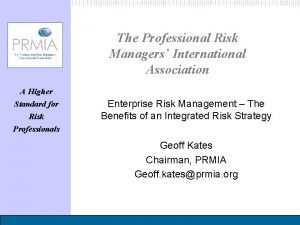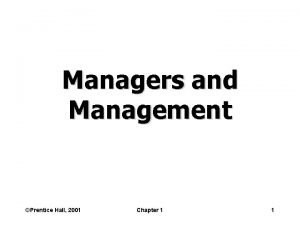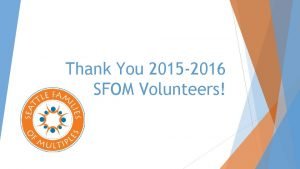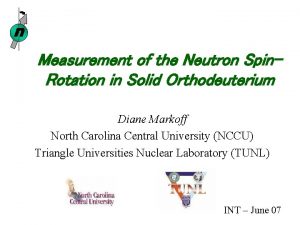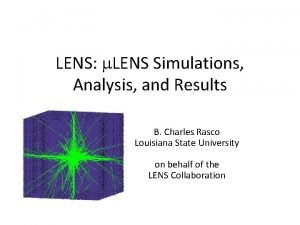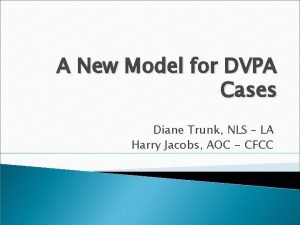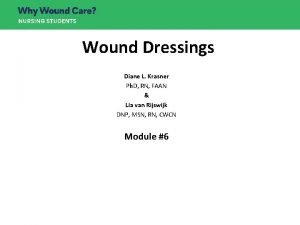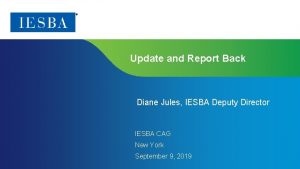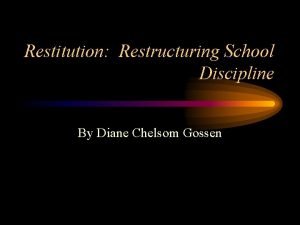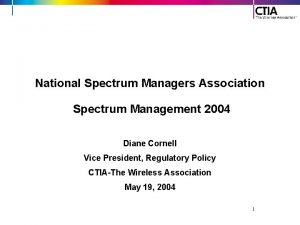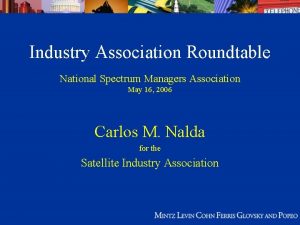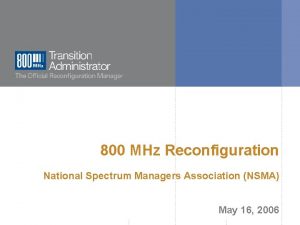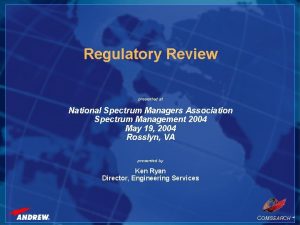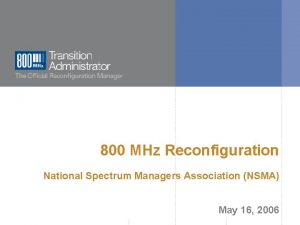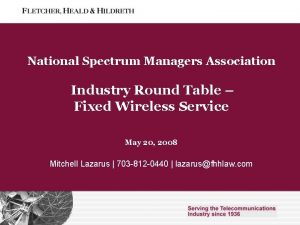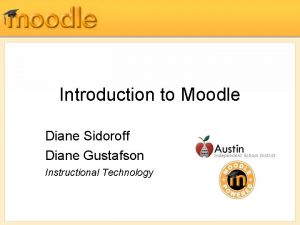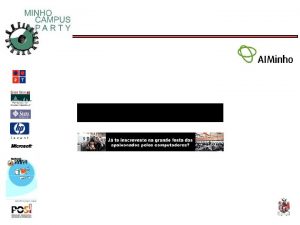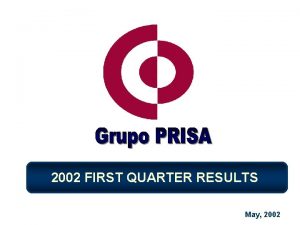National Spectrum Managers Association Spectrum Management 2002 Diane

























- Slides: 25

National Spectrum Managers Association Spectrum Management 2002 Diane Cornell Vice President for Regulatory Policy Cellular Telecommunications & Internet Association (CTIA) May 21, 2002

Cellular Telecommunications & Internet Association • CTIA is the international organization of the wireless communications industry for both wireless carriers and manufacturers. Membership in the association covers all Commercial Mobile Radio Service (“CMRS”) providers and manufacturers, including cellular, broadband PCS, ESMR, as well as providers and manufacturers of wireless data services and products. • CTIA is the voice of the wireless industry– representing its members in a constant dialogue with policy makers in the Executive Branch, the Federal Communications Commission, and in Congress. CTIA’s industry committees provide leadership in the area of taxation, roaming, safety, regulations, fraud, and technology.

Commercial Mobile Wireless Industry Has Experienced Massive Growth In An Incredibly Short Period Of Time Since 1998, the wireless industry “comes of age” – PCS subscribers top 10% of all subscribers – $50 billion capital investment – Wireless consumers – 2 x growth – Total minutes of use – 5 x growth 3

From Ancillary To Alternative February 1, 2002

Recent U. S. Subscriber Trends Suggest Penetration Will Continue To Exceed Forecasts ITU Estimate Current Penetration 5

Current Voice Trends • Total wireless minutes of use (MOUs) are growing at 75% year-toyear • Wireless is increasingly substituting for wireline service: – Wireless MOUs are increasing as a percentage of all telecom MOUs – 18% of wireless consumers consider their wireless phone their primary phone. – 10 -20 million wireline have been or are being replaced with wireless lines. – Wireless MOUs amounted to 12 percent of all telecommunications industry minutes in 2001 – Wireless MOUs are expected to amount to 40 percent of all telecom industry minutes by 2005 according to The Yankee Group. • 85% of wireless subscribers already use digital; 6

Projected Wireless MOUs Average Over 1 Trillion in 2005, Over 2 Trillion in 2010 7

Wireless Data Service Projections • In-Stat/MDR predicts two-thirds of American workers will use wireless devices as part of their jobs by 2004. • Jupiter Media Metrix estimates U. S. wireless web users will grow to 96 million by 2005. • Gartner Group projects 90 percent of professionals / telecommuters will use high-speed wireless data services by 2005, with 137 million wireless data users in North America. • AMI Partners projects half of entire U. S. workforce to be mobile by 2006, totaling 67 million workers, with over 26. 4 million commercial wireless data users. • In-Stat/MDR projects 52 million wireless data subscribers in 2005; 39 million business wireless data users in 2006. • Ovum projects overall U. S. wireless data penetration of 67 percent by 2007.

Wireless Data Service Projections • Personal use of laptops and PDAs for wireless e-mail and office system access will increase, as well as machine-to-machine communications, such as automated user updating by e-mail systems, and specialized applications such as medical monitoring, etc. • SMS: globally short message service / text messaging is growing dramatically – from 1 billion a day at year-end 2001 it is expected to reach 3 billion daily by year-end 2002. • Interoperability has been resolved in the U. S. , laying ground for SMS to take off in the next three years, with SMS message volumes reaching 150 billion a year. • Multi-media Messaging Service (MMS) combines text, images, audio and video, and is expected to build upon the SMS experience - including applications focused on both consumers and business users.

MHz Of Spectrum Available By Nation 10

What did we learn on September 11? • Networks built for “ancillary” usage— don’t have enough spectrum when called upon to support consumer demand during emergencies • Emergency interoperability a problem • Desire for prioritization of national security and emergency preparedness users 11

Spectrum Management Challenges • Additional Spectrum for Advanced Mobile Services • NTIA Plan • Trust Fund • Timing of Auctions • Delay of 700 MHz Auctions • Flexibility • Spectrum Allocation Reform 12

NTIA Plan Benefits U. S. Economy • International harmonization means scope/scale economies • 120 MHz supports mid-decade demand levels and multiple providers • Council of Economic Advisors — $500 billion consumer benefit over next decade 13

Global use of 1710 -1850 MHz for Mobile Services Current / Planned / Support usage of 1710 -1850 MHz Not enough information regarding planned use U. S. yet to make decision 14

Do. D Spectrum & NTIA Plan 15 MHz in NTIA Plan 80 MHz of Required by BBA 1997 & in NTIA Plan Industry 2001 “ask” not in NTIA Plan Government 1710 1755 1770 1850 15

Four Major Do. D Systems in 1755 -1770 MHz Band Tactical Radio Satellite Fixed Microwave Guided Munitions 16

“Win-Win” Solution – Conclusions • NTIA Plan eliminates most interference • Remaining interference can be fixed or managed • Comparable spectrum • Equipment upgrades • International commercial deployment complicates Do. D mission • Administration FY 2003 Budget endorses Spectrum Relocation Trust Fund • Administration FY 2003 Budget endorses revised auction timetable • • NTIA Plan provides vital commercial spectrum Guaranteeing Do. D Capabilities #1 Priority

700 MHz Auction Should be Delayed • Current Plans – June 2002 Auction • UHF Channels 60 -69: 60 MHz • 24 MHz – Public Safety • 6 MHz – Guardbands • 30 MHz – Commercial • UHF Channels 52 -59: 48 MHz – Commercial • Bidders need predictability on when they can have access to the bands to form business strategies. • Budget-driven dates are not the best way to further effective spectrum management or benefit consumers.

Movement Towards Flexibility “Friend or Foe? ” • Flexibility in allocations has broad support within the FCC and the Administration. • Flexibility is fast becoming regulators’ preferred solution to difficult, perplexing decisions. • Flexibility has arisen in several different contexts, e. g. : • FCC granted MMDS/ITFS incumbent licensees flexibility to provide mobile services in the 2500 MHz band. • FCC adopted a Notice of Proposed Rulemaking on two proposals from MSS operators to provide terrestrial services. 19

Flexibility: Two Perspectives PROPERTY RIGHTS MODEL: • Licensees who buy their spectrum at auction should be given property-like rights to do whatever they like within their assigned spectrum, provided they do not interfere with other licensees. COMMONS MODEL: • License would be subject to efforts by the FCC to improve the efficiency of utilization of the spectrum by allowing additional “flexible” uses in assigned spectrum. • Possibly results in additional services allowed to be provided in the licensee’s spectrum. 20

A Proposed Framework to Analyze Requests for Flexibility in the Use of Spectrum • First, determine whether reallocation of the relevant spectrum band is preferable to granting the requested flexibility. • If reallocation is not appropriate, determine whether the additional flexible rights can be auctioned, subject to appropriate service rules. 21

Spectrum Management Reform Need for process change is abundantly clear: • FCC Chairman Powell -- “Put simply, our Nation’s approach to spectrum allocation is seriously fractured… It is important that the Commission move from its traditional spectrum management paradigm of ‘command control’ to a paradigm of market-oriented allocation policy to provide more flexible allocations that allow multiple uses so that spectrum can be put to its highest and best use…. ” • NTIA Administrator Nancy Victory – “Our country’s spectrum needs are too important to be undermined by internecine squabbling between and among and within branches of government. ” 22

Spectrum Management: Procedural and Structural Reform Some ideas for procedural and structural reforms to improve efficiency of spectrum allocation process: • Create an interagency senior advisory group (ISAG) to facilitate decision-making on controversial spectrum matters. • Develop a “rolling” long-term spectrum planning process. • Create an “independent review” mechanism similar to the Base Realignment and Closure Commission (BRAC). 23

Procedural and Structural Reform (cont. ) • Designate an entity to contribute an independent voice on difficult sharing/interference and technical decisions. • Improve U. S. participation in the international spectrum process. • Create a relocation “trust fund” from auction proceeds. • Reform the satellite licensing process. 24

Contacting CTIA Cellular Telecommunications & Internet Association 1250 Connecticut Avenue, NW Washington, DC 20036 www. wow-com. com 202 -736 -2080 dcornell@ctia. org 25
 National association of residential property managers
National association of residential property managers Professional risk managers international association
Professional risk managers international association National health policy 2002
National health policy 2002 Dr. kanupriya chaturvedi
Dr. kanupriya chaturvedi Orbital diagram for cu
Orbital diagram for cu Absortpion
Absortpion Chapter 1 management
Chapter 1 management Managers and management chapter 1
Managers and management chapter 1 Managers and management chapter 1
Managers and management chapter 1 Robin laskowski
Robin laskowski Diane liu md
Diane liu md Diane markoff
Diane markoff Diane zapata
Diane zapata Diane markoff
Diane markoff Diane loth
Diane loth Diane hankins
Diane hankins Diane dalby
Diane dalby Diane thurston
Diane thurston Diane howie
Diane howie Diane curry
Diane curry Ce matin paroles
Ce matin paroles Diane trunk
Diane trunk Diane krasner
Diane krasner Diane glancy without title
Diane glancy without title Diane jules
Diane jules Diane gossen
Diane gossen

